Report
 }
}
Executive Summary
This is the seventh consecutive year that we've tracked the shopping behaviors of Chinese consumers. Our continuing research has given us a valuable long-term view across 106 fast-moving consumer goods (FMCG) categories purchased for home consumption in China. As in each of the past six years, we conducted a deep analysis of the key 26 categories1 that span the four largest consumer goods sectors: packaged food, beverages, personal care and home care. We also looked at another 24 categories2 to form a more comprehensive view of the market. Combined, these sectors represent 80% of all FMCG.
In addition, for the second year, we looked at FMCG and channel trends for 10 categories3 purchased for out-of-home consumption in Tier-1 and Tier-2 cities.
The big news is that value growth of FMCG has rebounded as China's expanding middle class continues to seek out upgraded consumer goods that serve to improve health and elevate their lifestyle. For the first time since we started tracking China's shopping behaviors, six years ago, the rate of total value growth increased over the previous year, from 3.6% in 2016 to 4.3% in 2017. This 4.3% growth is mostly the result of a 4% increase in average selling prices, which more than compensated for nearly stagnant overall volume growth.
From silicone-free shampoo to not-from-concentrate juice that's more natural and nutritious, Chinese consumers are spending more on premium goods—and they are doing it across the board. Out of 50 categories, 38 categories premiumized (average prices rose higher than the rate of inflation) while only 12 commoditized (average prices rose less than inflation).
In many ways, the "two-speed" phenomenon that we described in China Shopper Report 2016 still exists, but higher speeds are now more prevalent, driven by premiumization. Our findings in 2017 show that high-speed categories are steadily gaining more ground while many low-speed categories remain sluggish. This year we continued to examine the two-speed pattern through three lenses:
- The product category lens
- The channel lens
- The local vs. foreign brand lens
Product categories
As we saw in previous years, the food and beverage sectors and home care and personal care sectors tend to grow at different speeds. Both saw growth accelerate in 2017, even the typically underperforming food and beverages.4 The overarching force: premiumization.
The 5 fastest-growing categories in the last two years across the 50 categories we observed were mouthwash, kitchen rolls, pet food, makeup and soybean milk.
Food recovered from flat growth in 2016 in large part due to different forms of premiumization. Again, categories with strong health benefits performed particularly well. Nutrient supplements and cereals grew by 6% to 7%. Infant formula grew by 8.7%. In addition to its perceived health enhancements, infant formula was the beneficiary of China's two-child policy, which has boosted sales across all baby-related categories.
Another contributor to food premiumization: pleasure. Categories that provide better taste or more pleasure have demonstrated strong growth momentum. Instant noodle players Master Kong and Uni-President continued to introduce new premium products, such as Soup Master, to attract middle-class consumers. Jelly candy offered by UHA Cororo has created a new taste sensation thanks to juice injected inside the candy. Meanwhile, Peppa Pig branded biscuits use the popular cartoon character to create a strong emotional bond with customers, which in turn boosted sales growth.
This premiumization trend was observed in the beverage sector, too. Nongfu Shanquan achieved strong sales growth through an effective marketing campaign linking water to specific occasions, such as cooking rice. The company also personalized its products by printing consumers' comments on bottles.
Much of the growth comes from the southwest and central provinces as industries shift inland from the coast. As more consumers become premium buyers, these provinces continue to outperform the coastal provinces in terms of FMCG spending growth.
Primarily, brands boost premiumization in one of two ways. They raise prices on SKUs—this was the case in 2017 with products such as toothbrushes and hair conditioner. The other approach is to introduce more premium SKUs and increase the sales volume of existing premium SKUs.
Premium SKUs made gains in facial tissue, toothpaste, packaged water, toothbrushes, fabric softener, infant formula, skin care, instant noodles, personal wash, juice, kitchen cleanser, beer and toilet tissue. The biggest increases were in the facial tissue category, in which premium SKUs' value rose 17% compared with 2% growth among non-premium products.
This two-speed phenomenon across categories can easily be understood by looking at average income growth per capita and assuming a normal distribution of income. There will be more people at a higher income level who will spend more on categories and sectors that they now can afford; and, in parallel, there will be fewer people at a lower income level buying the categories that are the main focus of this lower income level.
Changing channels
For at-home consumption, hypermarkets continued to lose in popularity, with sales dropping by 2.5% as more consumers abandon their trips to big-box stores in favor of more convenient shopping options. Super- and minimarkets saw their sales grow by 4.8%, partly due to their role in the booming online-to-offline (O2O) delivery services. Traditional groceries continued to lose ground—sales declined by 5.4%. And, in a surprising finding, convenience stores, which posted high growth for the past five years, grew by only about 2%, the victims of expansion economics and competition from O2O delivery. Despite this growth slowdown for at-home consumption, convenience stores have vast opportunities to serve the expanding market for food and beverages sold for out-of-home consumption, which grew by 6.2% in 2017, based on the 10 food and beverage categories we tracked for China's Tier-1 and Tier-2 cities.
After rapid expansion since 2013, China's O2O market continued to grow by around 30% in 2017, with much of that expansion due to O2O services to homes, such as food and delivery, which grew at an astonishing 76% rate, according to iResearch. Competition has increasingly intensified, fueled by mergers, partnerships with e-commerce giants and the entry of DiDi, the car-hailing service platform. The company recently announced its plan to enter the O2O delivery market, launching a pilot program in Wuxi.
The out-of-home market clearly continues to be an opportunity for FMCG companies selling in China. Forward-thinking retailers such as Hema and Yonghui are inventing new ways to capture the out-of-home market through such moves as creating massive in-store dining areas. The occasion-based shopping experience not only enables retailers to make the most of the demand for out-of-home consumption, it also increases consumer stickiness.
As expected, online sales sustained strong momentum in 2017, growing by more than 28%. Online channels now represent about 10% of the market—twice as much as two years ago. Baby and beauty categories continue to be the most popular online purchases as Chinese consumers seek the quality and selection of foreign brands.
Our research shows that online penetration growth is shifting from higher-tier to lower-tier cities.5 At 73%, Tier-1 cities still have the highest online penetration. Yet lower-tier cities are catching up: Online penetration in Tier-3 and Tier-4 cities is growing at 18% and 17% annually, respectively.
And the three clusters of categories we identified last year, based on their digital penetration trajectory since 2012, continue to hold their own:
- Skin care, makeup, facial tissue, toilet tissue, shampoo, diapers, infant formula and biscuits have high online penetration and a strong upward trend.
- Beer, carbonated soft drinks and chewing gum have a low online penetration, reflecting characteristics that limit their online potential.
- A middle cluster of categories, spanning most personal care, home care and packaged food, is being aggressively promoted for online growth by top brands and e-commerce retailers.
The continuing battle between local and foreign brands
As we have consistently seen in each year's research, local players gained share over foreign competitors. Local brands grew by 7.7% in 2017, capturing a 98% share of market growth, while foreign brands increased by 0.4%. Local brands won share over foreign brands in 21 categories, while foreign brands gained share in only 4 categories.
There are many reasons for the steady success of local brands. For one thing, they have a better understanding of local demand. Also, they can make and execute decisions faster than their multinational counterparts. This allows them to adapt quickly to new trends. Finally, they benefit from a higher historical penetration6 in the lower-tier cities, where premiumization has started to take off.
While local brands benefit from these advantages, some multinationals are taking steps to improve their performance. Among their approaches: focusing more on generating faster innovation and improving their ability to serve the needs of younger consumers shopping online.
How brands can win
Take advantage of channel dynamics and anticipate future retail consolidation. Brands can invest to capture the steady growth of online sales. Also, in food and beverage categories, they can follow consumers into alternative channels, such as restaurants and tea and coffee shops, which are expanding with O2O delivery platforms. In addition, brands can invest to make the most of the dramatic changes in offline channels, as retailers adjust to "New Retail"—transforming themselves with new technologies such as augmented reality—to recreate an attractive shopping experience, and using their stores as delivery platforms.
Develop high-value and personalized products to make the most of the premiumization trend. As China's consumers become more sophisticated, they place more value on premium products that better meet consumer needs. And multinationals should continue to push imports from their other markets.
Become data-driven, consumer-centric companies. For example, they can generate proprietary consumer data to enable product innovation, pricing and promotion strategies. They can build the new capabilities and culture required to deliver this new consumer-centric operating model.
How retailers can win
Prepare for New Retail. As illustrated by the recent alliance between Sun Art and Alibaba, traditional retailers should prepare themselves for New Retail. For example, they can use data analytics to link shopper profiles with shopper behaviors as a way of increasing store traffic, improving churn management and offering more targeted promotions to boost margins.
Another important step involves integrating inventory and supply chain management with e-commerce retailers or solution platforms. Retailers could improve the cost and efficiency of capabilities such as warehouse management, inventory planning and last-mile delivery.
Redesign store portfolio and formats to better capture customers' needs. Retailers could optimize their shelf space and create more occasion- or experience-based space (e.g., in-store dining) to improve customer stickiness and make the most of the growing popularity of out-of-home consumption.
Make the store experience attractive again. Finally, stores should invest in digitalization, with such innovations as augmented reality, digital price tags, "magic mirrors" and sampling machines, to create better in-store experiences and a higher level of interaction and engagement with shoppers.
Full Report
Growth rebounds across FMCG product categories
China's market for fast-moving consumer goods (FMCG) rebounded in 2017, with total value growing by 4.3% compared with 3.6% in 2016. This represents the first time since we began tracking China's shopper behaviors in which sales grew faster than the previous year. Overall, the two-speed growth scenario we introduced in 2016 has continued to evolve, with some categories growing at a fast clip while others maintain a slower pace.
The food and beverage sectors, and home care and personal care sectors, which typically grow at different rates, registered healthy gains in 2017 (see Figure 1). The major reason for the rebound: Average selling prices rose by 4% in 2017, offsetting stagnant volume growth (see Figure 2). Online sales played a major role in China's FMCG recovery. Digging deeper into the data, we determined that total value growth would have been significantly lower—2.5% compared with 4.3%—if just physical store sales were considered (see Figure 3). Moreover, without online sales China's FMCG market would have witnessed negative volume growth and a smaller increase in average selling prices.
The 5 fastest-growing categories in the last two years based on the 50 categories we observed were mouthwash, kitchen rolls, pet food, makeup and soybean milk.
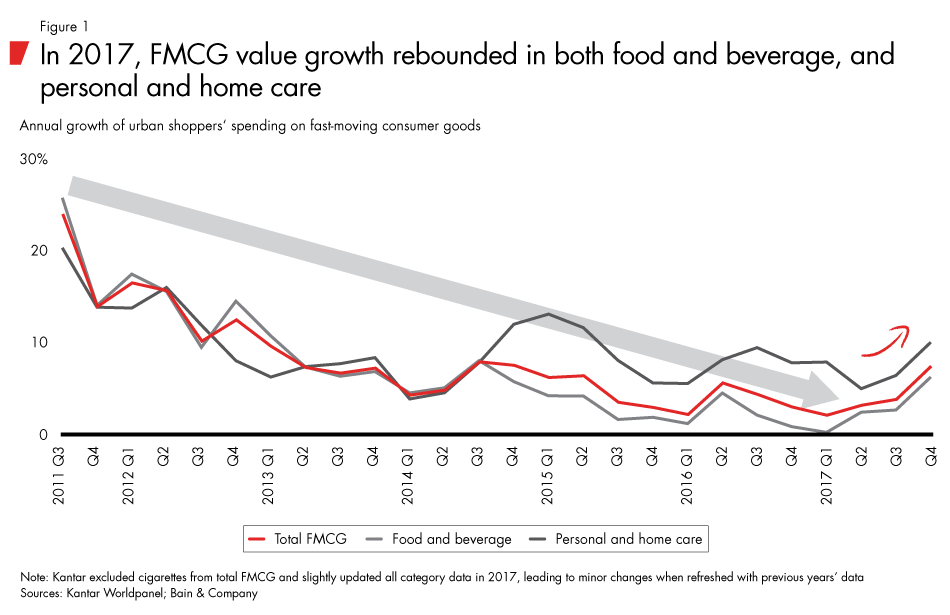

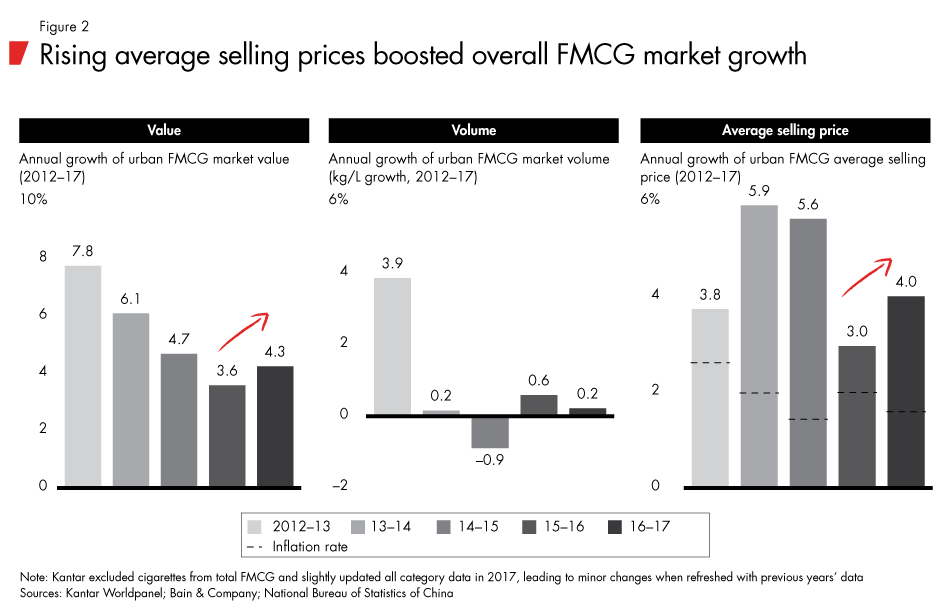

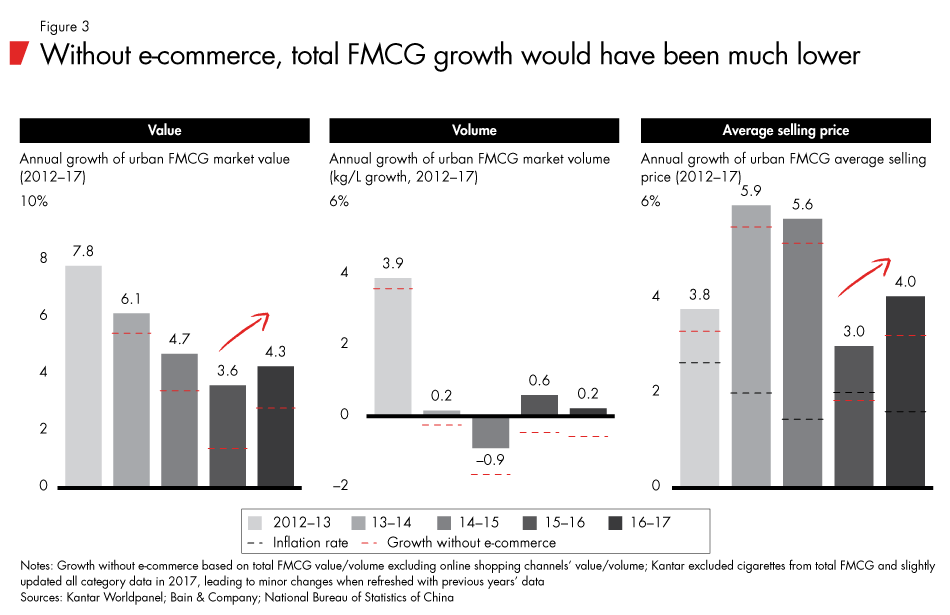

In the food and beverage sectors, the value growth of the packaged food categories outpaced that of beverages; packaged food's annual growth rose from 1.3% in 2016 to 3% in 2017. By contrast, the beverage categories' rate of growth rose from 2.3% to just 2.6% (see Figure 4).
A similar divergence took place in personal care and home care. Personal care categories registered a strong growth rate of 9.5% in 2017, largely due to average selling prices that gained 7.9%. But in home care, flat volume and low price growth combined to deliver shrinking value growth, which rose by 2.1% compared with 3.5% a year earlier (see Figure 5).
As China's two-speed growth trajectories continued in 2017, the distinctions between the two were becoming increasingly apparent. For example, mouthwash grew at an impressive 48.6% rate, and pet food by 17.5%— signs of Chinese consumers' desire to improve their health and lifestyle (see Figure 6). At the other end of the spectrum, MSG (monosodium glutamate) value dropped by 10.2%—further evidence of expanding health awareness.
In fact, the biggest theme emerging from the 2017 China Shopper survey may be the extent to which consumers are advancing in their efforts to live healthier and more enjoyable lives. From silicone-free shampoo to not-from-concentrate (NFC) juice that's more natural and nutritious, Chinese consumers are spending more on premium goods that deliver health benefits or elevate their lifestyle. Increasingly, they can afford it: Disposable household income per capita has grown at a compound annual rate of 8.2% over the past six years. Much of the growth comes from the southwest and central provinces as industries shift inland from the coast. These provinces continue to outperform the coastal provinces in terms of FMCG spending growth, as more consumers become premium buyers (see Figure 7).
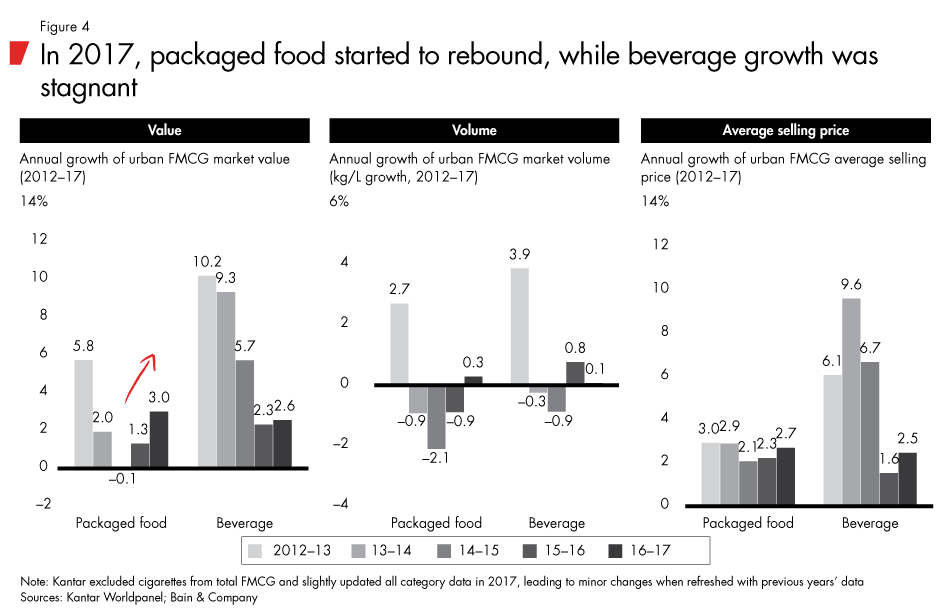

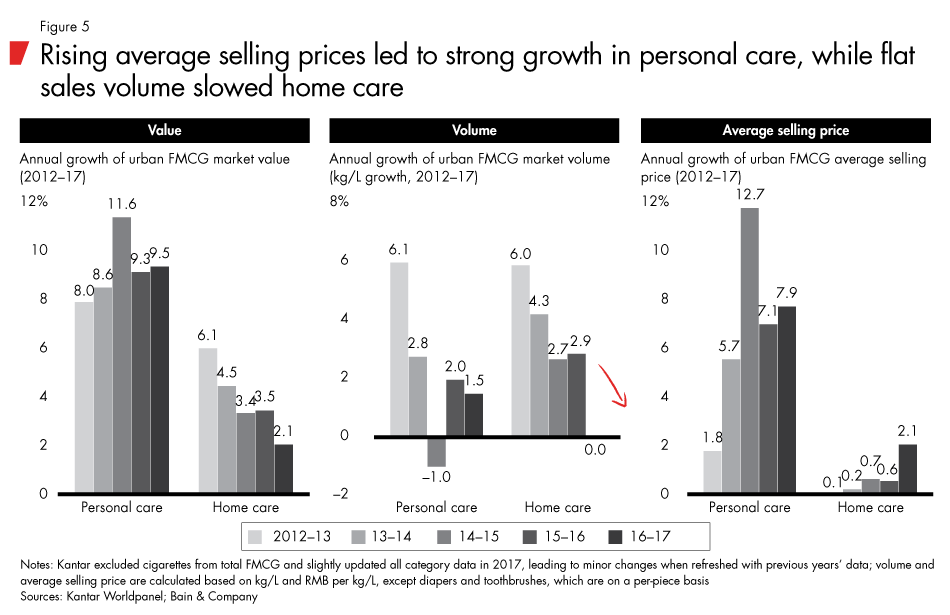

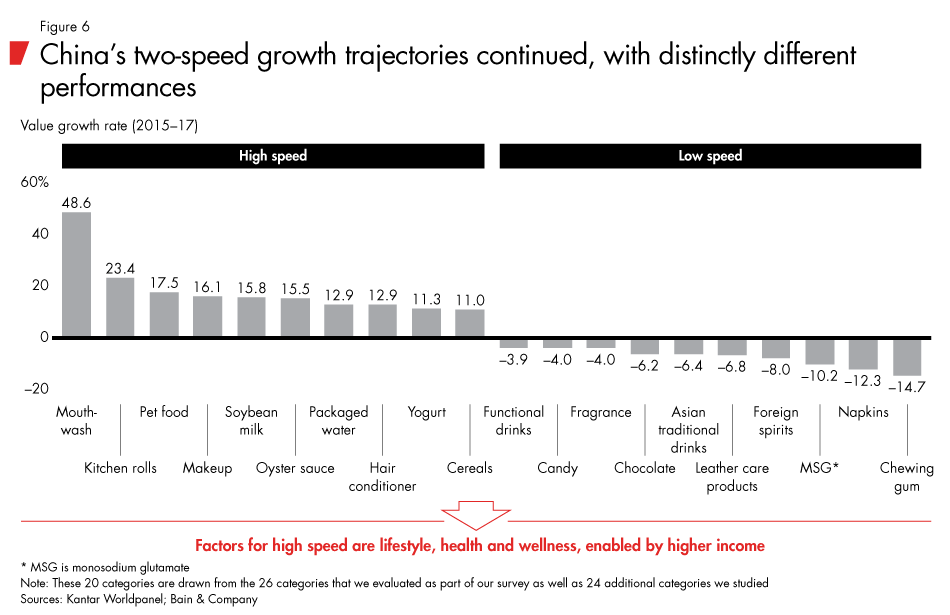

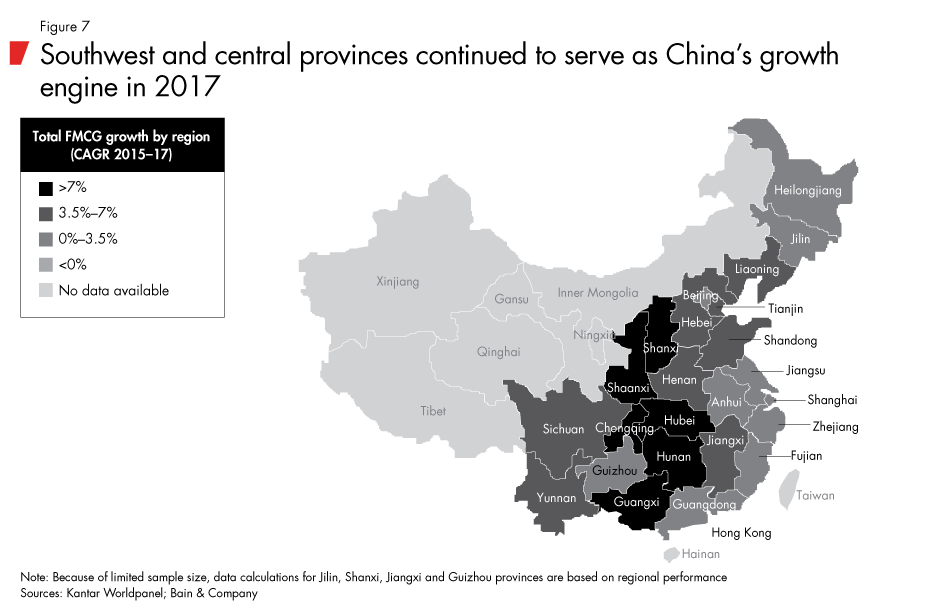

As China's expanding middle class seeks upgraded consumer goods that serve to improve health and elevate their lifestyle, brands are poised to grow.
A deeper look at premiumization by category
Because premiumization is fueling China's FMCG rebound, we decided to look at the specifics across the four major product sectors: food, beverages, personal care and home care. Brands primarily boost premiumization in one of two ways. They raise prices on SKUs—this was the case with products such as toothbrushes and hair conditioner in 2017. The other approach brands take is to introduce more premium SKUs and increase the sales volume of existing premium SKUs like facial tissue and yogurt. (see Figure 8).
Making food healthier. As we reported last year, food brands are catering to consumers' changing needs by upgrading their products for better taste or enjoyment. These companies continue to be rewarded for their efforts. Consider instant noodles, where leading players such as Master Kong and Uni-President are targeting middle-class consumers by continuing to introduce new premium product variations that have more ingredients and nutrition elements but fewer food additives—an effort we first chronicled in China Shopper Report 2017, Vol. 1, China's Two-Speed Growth: In and Out of the Home.
The same story is playing out in biscuits, which rebounded in 2017 with 4% value growth; the category's 4.7% average selling price growth offset a negative 0.6% volume decline. Some of that premiumization was the result of new product innovations, such as Mondelez's Oreo Relaunch program. The company has introduced a cross-category product called Milka-Oreo Chocolate. It also invented the Oreo music box, which uses Oreo biscuits to actually play songs. Consumers can personalize the packaging of their music box by choosing the pattern and color, as well as the text they want to print on the package.
Also, the category owes some of its recovery to marketing innovations intended to engage younger consumers, such as the use of the cartoon character Peppa Pig to sell biscuits. Another reason for premiumization in biscuits: the rise in online sales of imported products such as Nabati.
Companies are hoping to translate this success to sluggish categories such as candy, where UHA Cororo, a Japanese brand, has introduced an innovative jelly candy that is injected with juice and has enjoyed rapid growth in the last two years.
Food categories addressing specific occasions were able to grow with premiumization. For example, gifting is an occasion for purchasing premium goods. Lindt and other top chocolate brands enjoyed double-digit growth as premium chocolate is considered one of the best options for gifting.
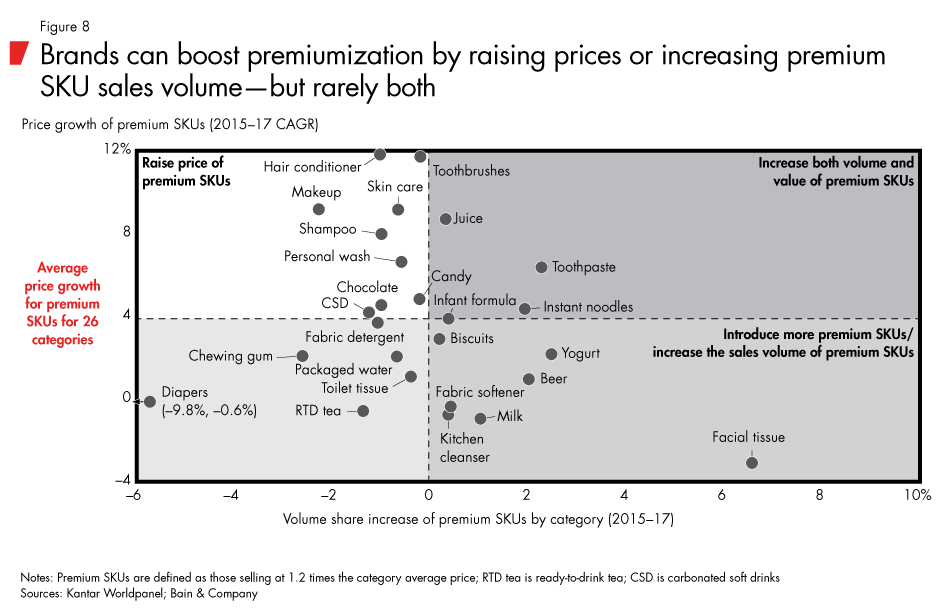

Unexpected competition in ready-to-drink (RTD) beverages. Beverages continued to grow at a lower rate than food categories. Value growth rose only slightly, from 2.3% in 2016 to 2.6% in 2017. Yet within this sector, healthy categories such as yogurt and packaged water maintained their ability to outpace categories considered less healthy. There is a downside. Yogurt's popularity has attracted many new local producers into the market, intensifying competition and dragging down average selling price growth. A clear sign: The promotion rate continued to increase in 2017, especially among lower-end products. The popularity of yogurt also had a negative effect on the sale of milk, which is viewed as being less tasty and less nutritious.
Packaged water maintained its popularity in 2017, but its growth was hurt by competition from such products as soda water. Yet, some brands found ways to outperform. For example, Nongfu Shanquan achieved 22% value growth from an effective marketing campaign linking water to specific occasions, such as cooking rice. Another smart move: personalizing products by printing consumers' comments on bottles.
Such innovative efforts spurred growth in unexpected beverage categories. Carbonated soft drinks, which had been losing steam in recent years, recovered with 6.3% value growth, thanks to new healthy concepts and new product lines that boosted average selling prices by 4.2%. Watson's and Mingren promoted the health-related features of their soda water products—emphasizing the zero-sugar content and the benefit of keeping body acid and alkaline in balance. Coca-Cola introduced Sprite Zero, launched new Coke flavors such as Sakura and Cherry and introduced smaller packages and sleek cans. It also personalizes product packages each summer to increase consumers' emotional connection with the brand.
While the juice category grew by only 1.9% in 2017, the same premiumization lessons applied. Brands such as Nongfu and Infinitus achieved more than 20% growth, partly because of their fresher, more natural NFC products.
Finally, the premiumization trend is also playing out beyond the non-RTD category. Consider the activity in RTD tea. Overall, RTD tea value growth declined by 2.6%, the result of a 2.2% drop in volume. Yet some brands are capturing much of the growth with innovative portfolios (mixing different ingredients with a base of Chinese tea) and making the most of out-of-home channels such as the new tea shops proliferating in China. These brands are reenergizing the ways Chinese consumers enjoy their tea.
High-velocity growth for major and niche brands alike in personal care. Personal care categories performed well in 2017, achieving 9.5% value growth based on a 7.9% increase in average prices and 1.5% volume growth.
Big luxury brands such as YSL and Lancôme were a major force behind the success of beauty categories (make-up and skin care). For example, YSL tripled its sales in 2017, primarily due to its popular lipstick products. At the same time, Chinese brands such as Pechoin and Chando are growing swiftly, too.
Hair care categories (shampoo and conditioner) continued to perform strongly. A few big brands such as Clear achieved high value growth in 2016–17. Premium niche brands performed even better, albeit from a lower base. Unique innovations made the difference. SeeYoung, the first brand to introduce silicone-free shampoo in China, grew by more than 105% from 2015 to 2017. That success spurred the major brands to release their own versions of silicone-free shampoo. Meanwhile, Ryo, a top-selling Korean premium brand of hair and scalp treatment products with herbal ingredients, grew 22% in 2017.
The rising concerns with health and appearance mean that more people in China are attending to their oral hygiene. Electric toothbrushes and mouthwash both registered strong gains—another example of premiumization.
But the diaper category shows a different pattern. China's two-child policy has delivered a steady rise in the number of births—more than 17 million babies were born in China in 2017. That has contributed to 12.3% volume growth in diapers. However, nearly half of that volume is sold on promotion, resulting in a 5% decline in average selling price for the diaper category. Although foreign brands still dominate in diapers, there are a few domestic companies gaining presence. Local brands such as Lelch grew by more than 120% in 2017, and Care Daily emerged as one of the top-selling brands within a year of its launch.
Non-necessities win in home care. Value growth declined in home care, from 3.5% to 2.1%, the result of 2.1% average selling price growth and stagnant volume growth. Yet, categories that serve specific needs beyond daily necessities, such as facial tissue and fabric softener, outpaced other categories.
- Facial tissue value rose by 9.2%, as Chinese consumers increasingly substituted it for less-expensive toilet paper in such common household uses as wiping tables.
- Fabric softener grew by 5.3% as brands promoted more specific needs, such as removing static electricity and infusing clothes with long-lasting fragrance.
- Toilet tissue continued to decline in volume, dropping by 8.9%. However, average prices rose by 10.3% as consumers traded up from two-ply to three- and four-ply tissue. Rising costs of raw materials also contributed to the price increases.
Despite gains made by local companies in the premiumization game, China's consumers still view imported goods as being safer, of higher quality, better tasting or more innovatively designed than domestic goods. That is why most premiumizing categories have a higher rate of import growth than other categories. This is especially true for makeup, personal wash, toothpaste, toothbrushes, yogurt, packaged water, carbonated soft drinks, instant noodles and facial tissue.
Imports—much of which are in baby and beauty categories—make up 39% of all online FMCG sales as Chinese online shoppers continue to evolve in their view of e-commerce (see Figure 9). Initially, they saw online as a place to find bargains. Gradually, they have been relying on the channel to buy premium products and niche brands. They have advanced from value hunters to quality seekers.
For FMCG companies, a nagging reality of e-commerce is its high rate of promotions. For example, on average, 39% of FMCG purchased online were bought on promotion—almost twice the percentage of offline products bought on promotion (see Figure 10). However, this phenomenon is stabilizing as more Chinese consumers go online for quality—as opposed to bargains—and as e-commerce platforms reposition their huge digital festivals from primarily bargain events to brand-building and product introduction campaigns.
The macroeconomic underpinning of the two-speed phenomenon is easily understood in a chart developed by Gavekal Dragonomics (see Figure 11). Assuming a normal distribution of income, as average income per capita increases by 25% (which happened in the last three years), then the share of the population with income greater than $15,000 increases from 2.3% to 15.9%. That's nearly a sevenfold increase, which fuels the fast growth of premium categories and segments that are expanding at high speed. Likewise, the low-speed categories and sectors feel the opposite effects from the reduced share of lower-income earners.
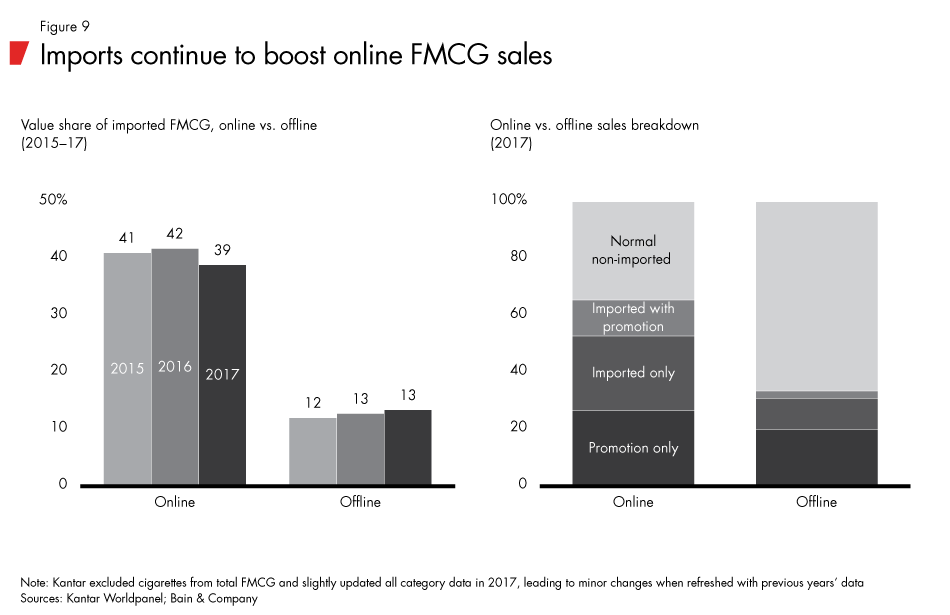

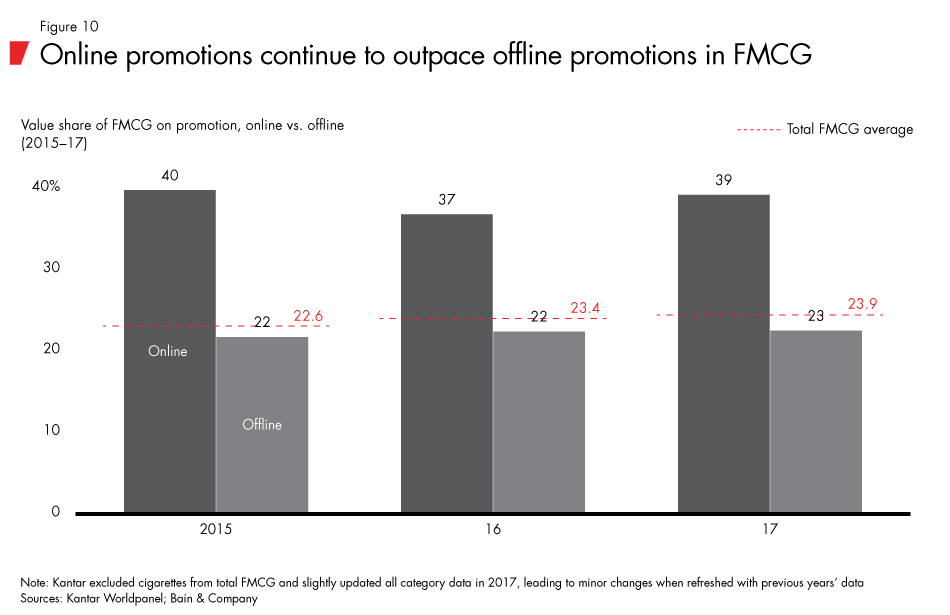

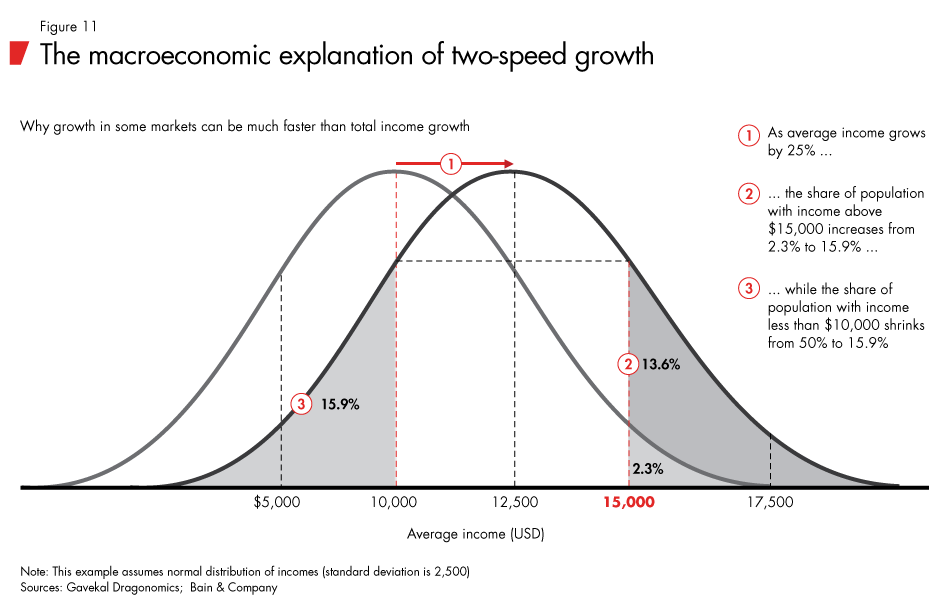

Shifting channels at home and out of home
In 2017, China's shoppers continued showing their preference for shopping online over making trips to the hypermarket. While online sales maintained strong momentum, sales at big-box retailers slowed or even declined (see Figure 12). E-commerce sales grew by more than 28% last year and now represent about 10% of the market—twice as much as two years ago. Online penetration growth is shifting from higher-tier to lower-tier cities. At 73%, Tier-1 cities still have the highest online penetration (see Figure 13). Yet lower-tier cities are catching up. For example, online penetration in Tier-3 and Tier-4 cities is expanding at 18% and 17% annually, respectively, putting them between two and three years behind Tier-1 cities. Meanwhile, Tier-5 cities are experiencing a 21% annual increase in online penetration.
Baby and beauty categories continue to be the most popular online purchases as Chinese consumers seek the quality and selection of foreign brands (see Figure 14). Diapers, for example, maintained their status as the category with the highest relative online penetration7 (64%) and highest online sales value share (45%).
As we saw in previous years, categories continued to form three clusters based on their digital penetration (see Figure 15). The first cluster consists of eight categories that have a high online penetration and a strong upward momentum: skin care, shampoo, infant formula, diapers, biscuits, makeup, toilet tissue and facial tissue. On the opposite end are categories with low online penetration, meaning no significant growth in the past five years.
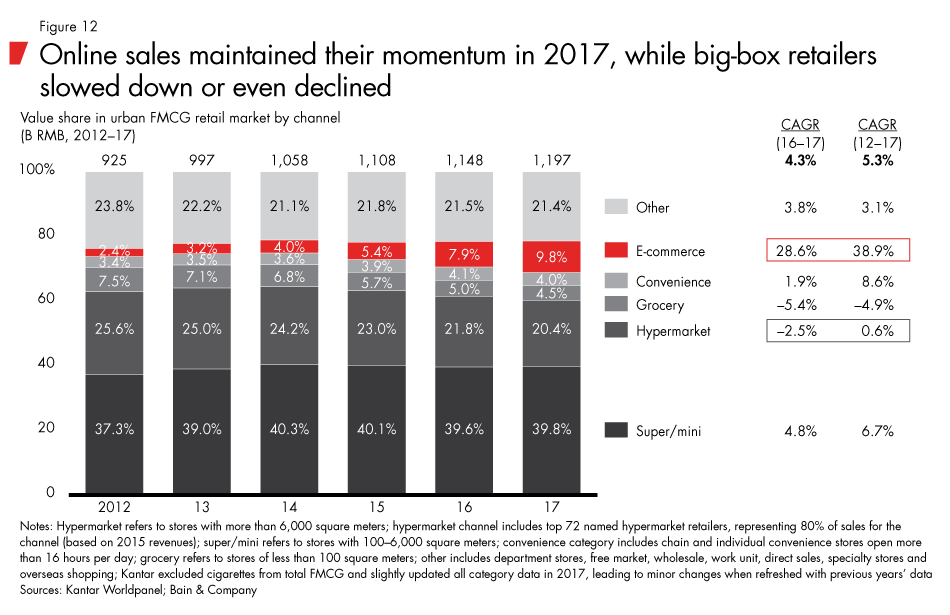

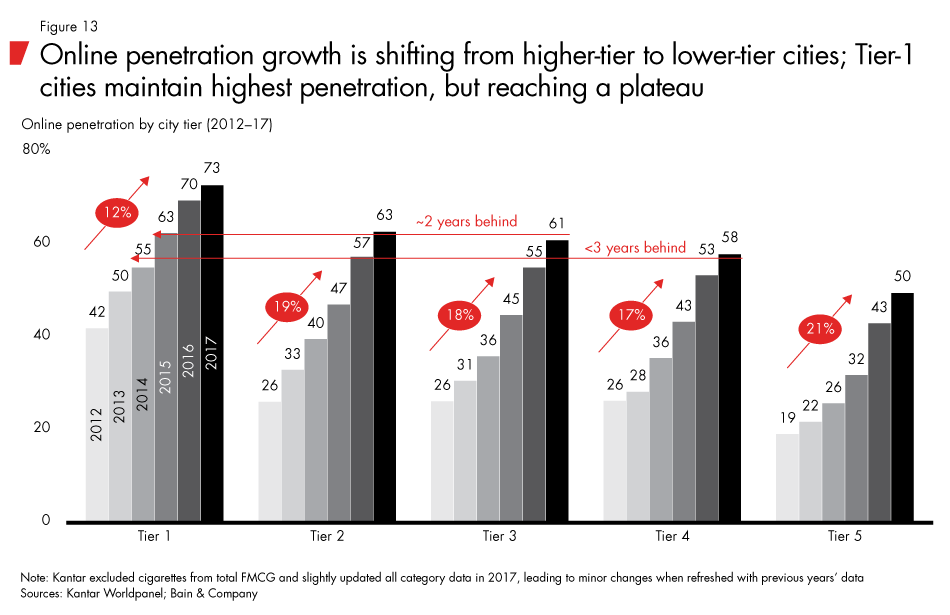

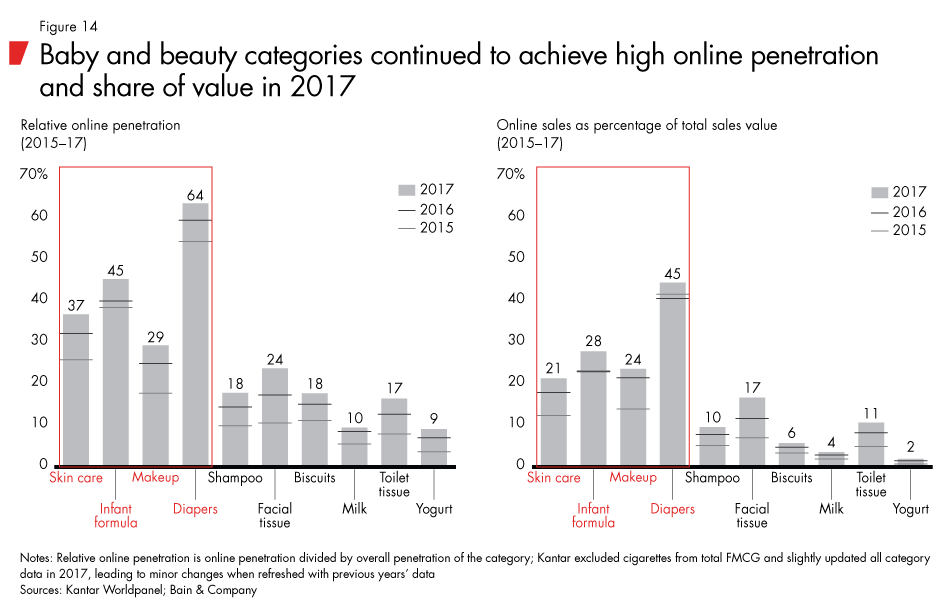

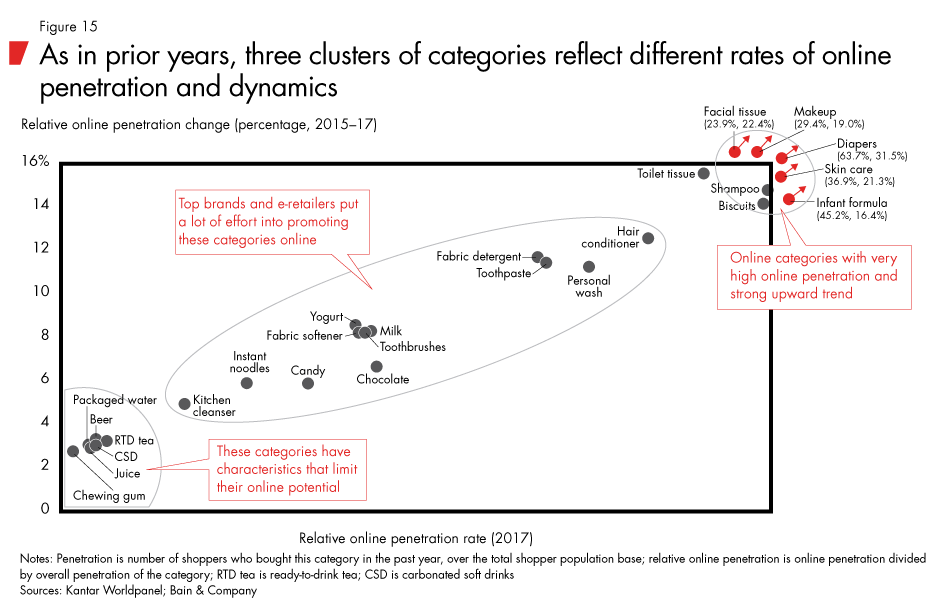

This is the case with such impulse categories as chewing gum and beverage categories in which the last-mile delivery costs are high compared with the average selling price. A middle cluster includes most personal care, home care and packaged food categories. Many of these categories are strongly promoted by top brands and e-tailers.
In stark contrast to the boom in online penetration, China’s hypermarkets are dealing with declines in everything from shopping frequency to volume per household to penetration (see Figure 16). Instead of traveling to hypermarkets, China’s consumers prefer the convenience of online channels or the newly popular online-to-offline (O2O) delivery services. This trend is leading to innovative variations that integrate online and offline shopping. For example, to offset declining traffic, Walmart has collaborated with JD.com to integrate online and offline shopping. So have Sun Art and Alibaba. WuMart has invested in New Retail platform Dmall to enhance its overall capabilities in everything from its customer management system to inventory and supply chain system to auto payments. Alibaba’s Hema and Yonghui’s Super Species have dramatically expanded their futuristic New Retail stores to provide seamless omnichannel shopping experiences. And the first Carrefour Le Marche “smart store” just launched in Shanghai, offering self-payment via facial recognition and WeChat, as well as on-site cooking services.
Super- and minimarket retail channels benefit from O2O delivery services because of their stores' proximity to local neighborhoods as pickup locations. Those channels grew by 4.8% in 2017.
After rapid expansion since 2013, China's O2O market continued to grow by around 30% in 2017, with much of that expansion due to O2O services to homes, such as food and delivery, which grew at an astonishing 76% rate, according to iResearch. Competition has increasingly intensified, fueled by mergers with e-commerce giants. The previous three kingdoms formed by Ele.me, Meituan and Baidu ended when Ele.me acquired Baidu's O2O delivery business. Ele.me was later acquired by Alibaba, forming a two-party combat situation with Meituan, which is backed by Tencent. The entry of DiDi, the car-hailing service platform, further complicated the situation. DiDi recently announced its ambition to enter the O2O delivery market, and launched a pilot program in Wuxi.
But the new O2O delivery boom is hurting traditional trade channels, which saw a 5.4% decline for at-home consumption sales. The best prospects for traditional trade are in sales for out-of-home consumption, which are rising by 6.2% across all channels (see Figure 17). Traditional grocers sold 15.6% more goods for out-of-home use across the 10 large food and beverage categories in our study. We expect traditional grocers to continue to do well, as both digital giants and other independent platforms have the ambition to transform the traditional grocery store landscape with electronic route-to-market (e-RTM) models.
It's a similar story with convenience channels. In last year's reports, we discussed how convenience channels were gaining in popularity, largely because of their ability to serve consumers purchasing food and beverages for out-of-home consumption, which represents as much as 85% of their total sales (see Figure 18). However, high rents for urban locations have slowed their expansion. Moreover, as we are seeing with traditional trade, competition from O2O delivery services has hurt convenience stores' sales of food and beverages for at-home consumption. After five years of solid growth, sales for at-home consumption rose only 1.9%. By comparison, food and beverage for out-of-home consumption registered a healthy 6.8% growth rate. As with traditional trade, it is a part of their business that has more room for growth.
The out-of-home market clearly continues to be an opportunity for FMCG companies selling in China. Forward-thinking retailers such as Hema and Yonghui are inventing new ways to capture the out-of-home market through such moves as creating massive in-store dining areas. The occasion-based shopping experience enables retailers to make the most of the demand for out-of-home consumption—and it increases consumer stickiness.
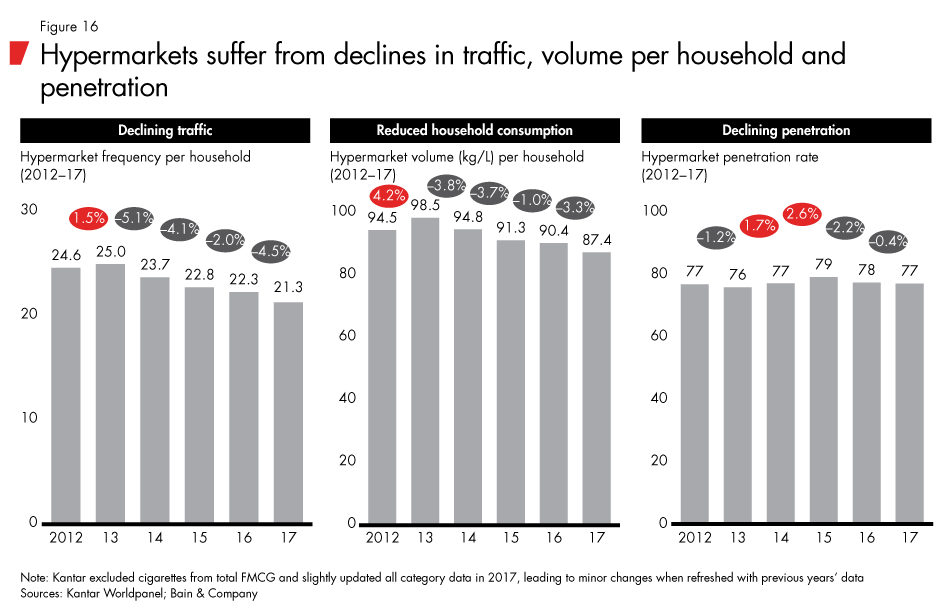

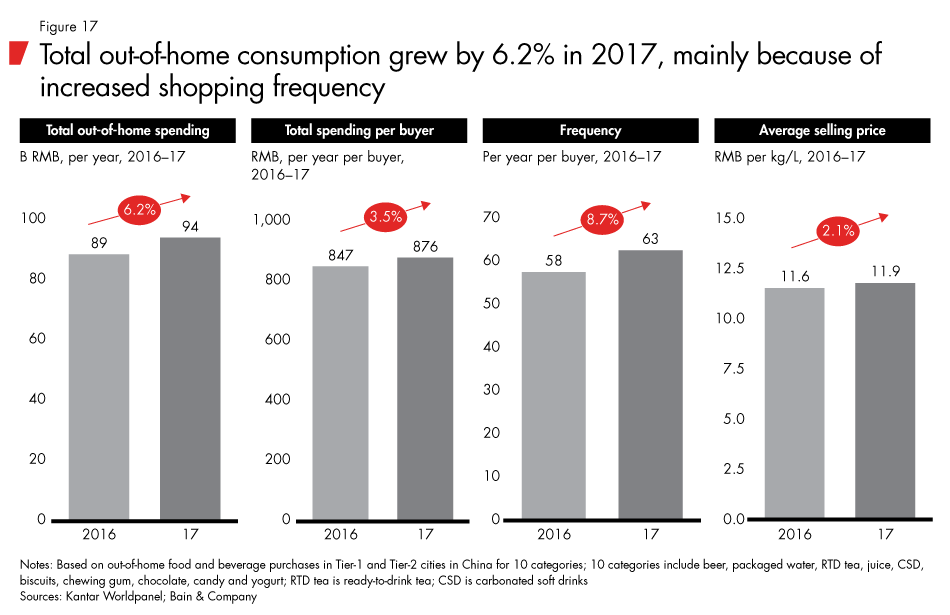

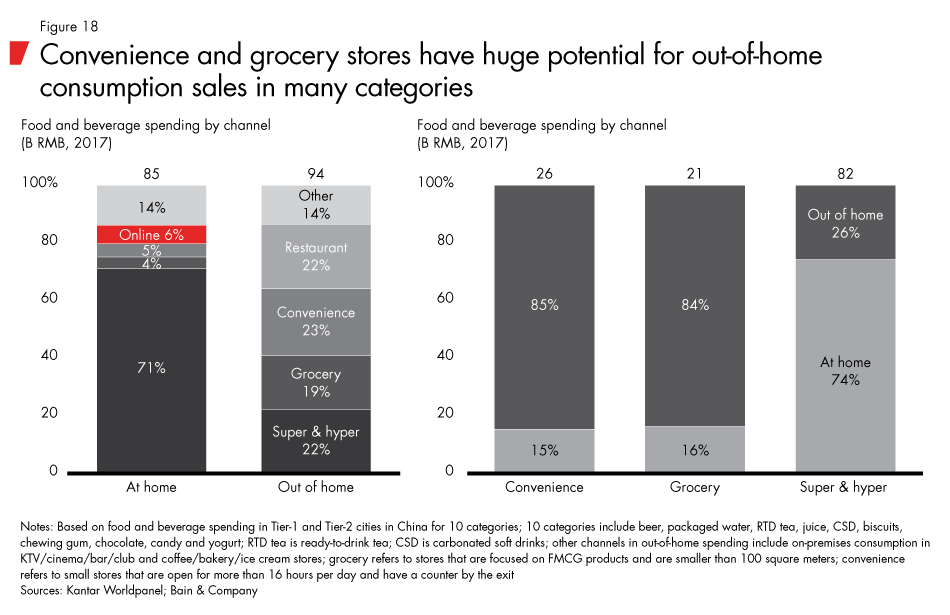

A look at growth by geography
Similar to the results of our 2016 survey, FMCG value growth in China does not vary much by city tiers. Across all tiers, the growth rate is converging toward 4%–5%. Instead, variations take place at the province level. The southwest and central provinces continue to outperform the coastal provinces as industries shift inland, spurring a mass migration.
Continuing battle between local and foreign brands
As we have consistently seen in each year's research, local players gained share over foreign competitors. Local brands grew by 7.7% in 2017, capturing 98% of market growth, while foreign brands increased by 0.4% (see Figure 19). Local brands won share over foreign brands in 21 categories while foreign brands gained share in only 4 categories. RTD tea was the only category in which there was no change (see Figure 20).
While local brands remain strong, some multinationals are taking steps to improve their performance. Among their approaches: focusing more on faster innovations and serving younger consumers shopping online.
There are many reasons for the success of local brands. They have a better understanding of local demand and are faster at making and executing decisions. This allows them to adapt quickly to new trends. Also, they benefit from a higher historical penetration in the lower-tier cities, where premiumization has started to take off.
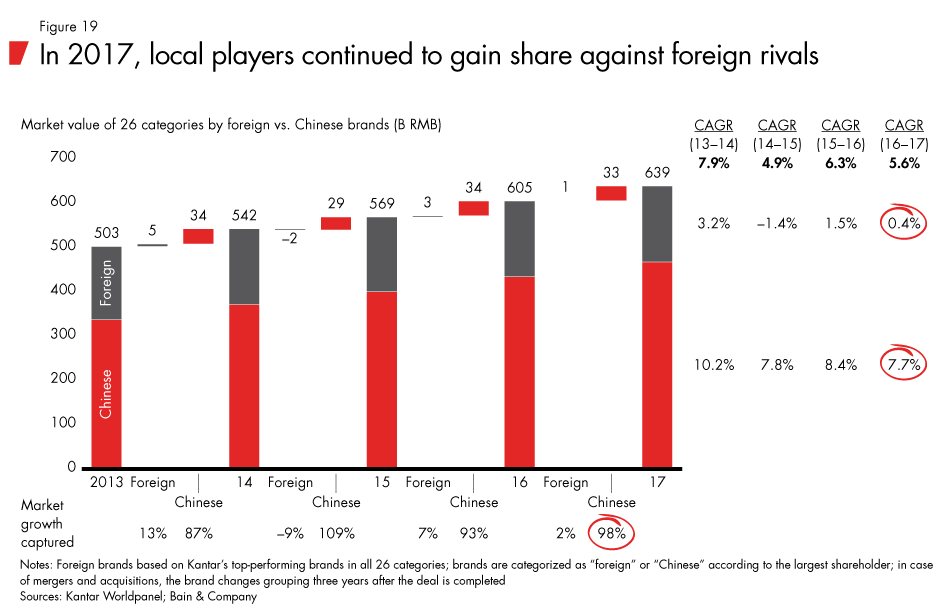

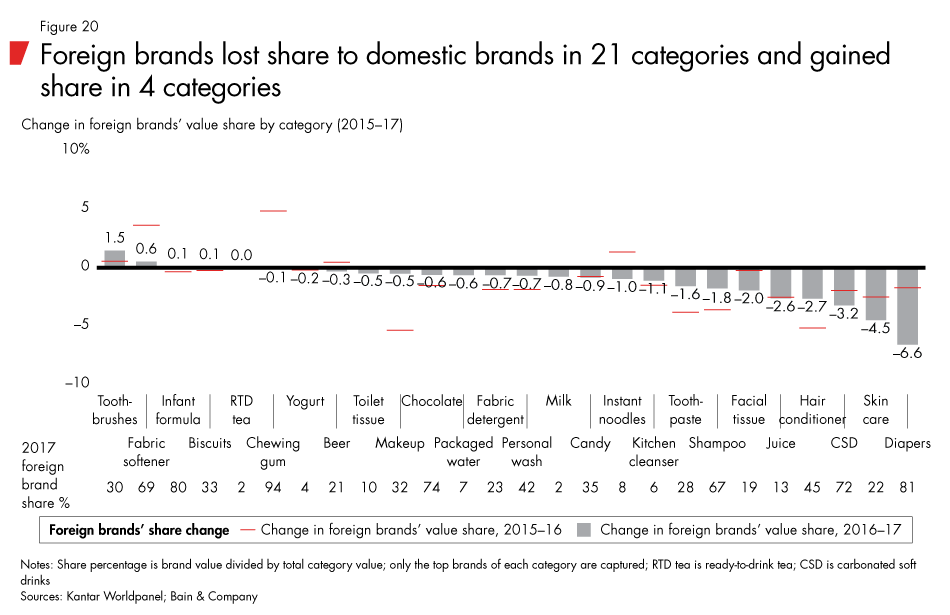

Examples of how local companies gain an edge:
They appeal to the right niche and cater to local consumers' specific needs. Among toothpaste brands, Saky (brand share 5%) specifically designs logos and wrappers to appeal to rising middle-class and young consumers, upgrading its packaging, for example, to feature images of famous landscapes. YNBY (brand share 15%) focuses on its toothpaste's ability to heal such ailments as gingival bleeding. A local juice producer, Kaiwei (brand share 1.8%), has marketed its haw juice product mainly in the northeast region, where people are more familiar with haw. The company also sells heavily to out-of-home channels such as restaurants.
They develop innovative products and concepts to create "white space." New Hope (brand share 0.8% for milk, and 1.7% for yogurt) is an emerging dairy brand that has introduced a "fresh strategy" milk product that is produced and brought to the shelf within 24 hours. Saky achieves double-digit growth with such products as Morning+Night toothpastes that are intended for different times of the day. The company plans to partner with local community dental clinics to establish 8,000 full-service oral care centers. Le Pur, a young brand that sells premium yogurt mostly online, has innovatively engaged customers to vote for new flavors and packaging. The brand also builds flagship stores to enhance the offline customer experience. Coca-Cola has recently invested in the company.
They use omnichannel to enhance consumer engagement. Makeup brand Marie Dalgar (brand share 1.5%) has used extensive content marketing through social media, such as leveraging key opinion leaders on Weibo. The brand also created occasion-based connections with consumers via partnerships with companies ranging from KFC to Pechoin. To build its fashion image, Marie Dalgar sponsors art shows and links its name with prestigious designers and makeup artists.
How brands can win
Take advantage of channel dynamics and anticipate future retail consolidation. Brands can invest to capture the steady growth of online sales. Also, in food and beverage categories, they can follow consumers into alternative channels, such as restaurants and tea and coffee shops, which are expanding with O2O delivery platforms. In addition, brands can invest to make the most of the dramatic changes in offline channels, as retailers adjust to "New Retail"—transforming themselves with new technologies such as augmented reality—to recreate an attractive shopping experience, and using their stores as delivery platforms.
Develop high-value and personalized products to make the most of the premiumization trend. As China's consumers become more sophisticated, they place more value on premium products that better meet consumer needs. And multinationals should continue to push imports from their other markets.
Become data-driven, consumer-centric companies. For example, they can generate proprietary consumer data to enable product innovation, pricing and promotion strategies. They can build the new capabilities and culture required to deliver this new consumer-centric operating model.
How retailers can win
Prepare for "New Retail." As illustrated by the recent alliance between Sun Art and Alibaba, traditional retailers should prepare themselves for New Retail. For example, they can use data analytics to link shopper profiles with shopping behaviors as a way of increasing store traffic, improving churn management and offering more targeted promotions to boost margins.
Another important step involves integrating inventory and supply chain management with e-commerce retailers or solution platforms. Retailers could improve the cost and efficiency of capabilities such as warehouse management, inventory planning and last-mile delivery.
Redesign store portfolio and formats to better capture customers' needs. Retailers could optimize their shelf space and create more occasion- or experience-based space (e.g., in-store dining) to improve customer stickiness and make the most of the growing popularity of out-of-home sales.
Make the store experience attractive again. Finally, stores should invest in digitalization, with such innovations as augmented reality, digital price tags, "magic mirrors" and sampling machines to create better in-store experiences and a higher level of interaction and engagement with shoppers.
1 These 26 categories are a) packaged food: biscuits, chocolate, instant noodles, candy, chewing gum and infant formula; b) beverages: milk, yogurt, juice, beer, ready-to-drink (RTD) tea, carbonated soft drinks (CSD) and packaged water; c) personal care: skin care, shampoo, personal wash, toothpaste, makeup, hair conditioner, diapers and toothbrushes; and d) home care: toilet tissue, fabric detergent, facial tissue, kitchen cleanser and fabric softener.
2 These 24 categories are pet food, oyster sauce, cereals, MSG (monosodium glutamate), Asian traditional drinks, functional drinks, kitchen rolls, wet tissue, napkins, leather care products, batteries, fragrance, hair removal, hair styling, ice cream, nutrient solid drinks, frozen food, flavor powder, foreign spirits, soybean milk, mouthwash, Chinese spirits, cooking oil and nutrient supplements.
3 These 10 categories are beer, packaged water, RTD tea, juice, CSD, biscuits, chewing gum, chocolate, candy and yogurt.
4 Kantar Worldpanel has excluded cigarettes from total FMCG data and has updated all category data in 2017 accordingly, leading to some inconsistencies with previous years' data.
5 Online penetration is defined as the number of people who bought online at least once per year divided by the number of people who bought the category at least once.
6 Penetration is defined as the percentage of households in a market buying a particular brand in a given year.
7 Relative online penetration is defined as the total number of online purchasers divided by the number of purchasers of the category.
Bruno Lannes is a partner with Bain's Shanghai office. You may contact him by email at bruno.lannes@bain.com. Jason Ding is a partner with Bain's Beijing office. You may contact him by email at jason.ding@bain.com. Marcy Kou is CEO at Kantar Worldpanel Asia. You may contact her by email at marcy.kou@kantarworldpanel.com. Jason Yu is Managing Director at Kantar Worldpanel Great China. You may contact him by email at jason.yu@ctrchina.cn.
This report is a joint effort between Bain & Company and Kantar Worldpanel. The authors extend gratitude to all who contributed to this report, in particular Iris Wang, Hardy Huang and Wenhuan Chang from Bain; and Rachel Lee, Tina Qin, Robin Qiao and Josh Xu from Kantar Worldpanel.
This work is based on secondary market research, analysis of financial information available or provided to Bain & Company and a range of interviews with industry participants. Bain & Company has not independently verified any such information provided or available to Bain and makes no representation or warranty, express or implied, that such information is accurate or complete. Projected market and financial information, analyses and conclusions contained herein are based on the information described above and on Bain & Company's judgment, and should not be construed as definitive forecasts or guarantees of future performance or results. The information and analysis herein does not constitute advice of any kind, is not intended to be used for investment purposes, and neither Bain & Company nor any of its subsidiaries or their respective officers, directors, shareholders, employees or agents accept any responsibility or liability with respect to the use of or reliance on any information or analysis contained in this document. This work is copyright Bain & Company and Kantar Worldpanel and may not be published, transmitted, broadcast, copied, reproduced or reprinted in whole or in part without the explicit written permission of Bain & Company and Kantar Worldpanel.